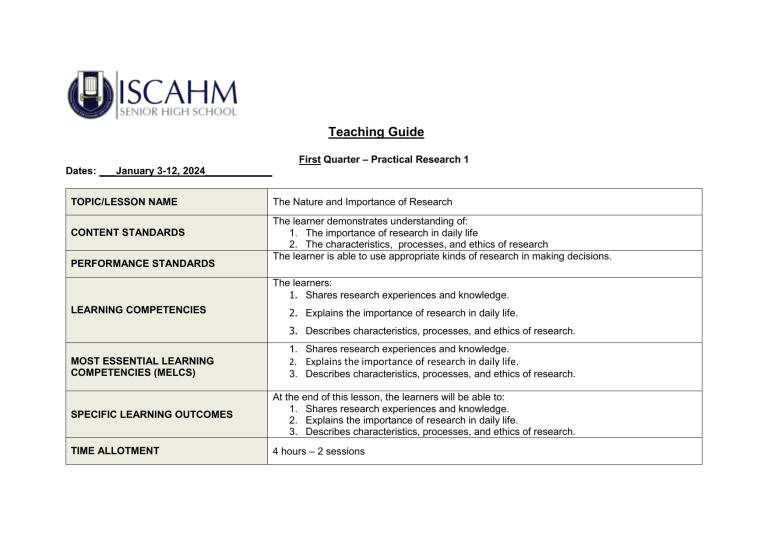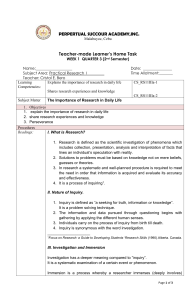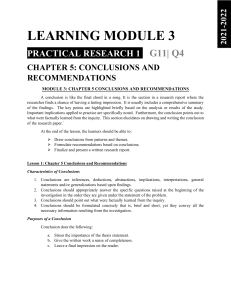
Teaching Guide First Quarter – Practical Research 1 Dates: ___January 3-12, 2024____________ TOPIC/LESSON NAME CONTENT STANDARDS PERFORMANCE STANDARDS The Nature and Importance of Research The learner demonstrates understanding of: 1. The importance of research in daily life 2. The characteristics, processes, and ethics of research The learner is able to use appropriate kinds of research in making decisions. The learners: 1. Shares research experiences and knowledge. LEARNING COMPETENCIES 2. Explains the importance of research in daily life. 3. Describes characteristics, processes, and ethics of research. MOST ESSENTIAL LEARNING COMPETENCIES (MELCS) 1. Shares research experiences and knowledge. 2. Explains the importance of research in daily life. 3. Describes characteristics, processes, and ethics of research. SPECIFIC LEARNING OUTCOMES At the end of this lesson, the learners will be able to: 1. Shares research experiences and knowledge. 2. Explains the importance of research in daily life. 3. Describes characteristics, processes, and ethics of research. TIME ALLOTMENT 4 hours – 2 sessions LESSON OUTLINE: 1. Introduction 2. Motivation 3. Instruction 4. Practice 5. Enrichment 6. Evaluation : : : : : : Introduce topic outline of the subject course. 4 Pics 1 Word Activity and Tree Mapping Activity to illustrate the topic. Demonstration and lecture discussion of the topics. Explain Me Activity (By Group) to further explain the topic. Activities on the book were given to deepen their understanding Written Exam Laptop, Projector, Chalk board, Marker MATERIALS RESOURCES Book: DIWA Senior High School Series: Practical Research 1 Author: Ruel Atendido Avilla PROCEDURES 1. INTRODUCTION The teacher explains to the students the objectives of the topic. At the end of this lesson, the learners will be able to: 1. Shares research experiences and knowledge. 2. Explains the importance of research in daily life. 3. Describes characteristics, processes, and ethics of research. 2. MOTIVATION 4 PICS ONE WORD Identify the word that is being illustrated in the following pictures. ________ MEETING THE LEARNERS’ NEEDS Teacher Tip: Teacher Tip: Tree Mapping Give words that define or relate to the word Research. Research 3. INSTRUCTION I. What is Research? 1. Research is defined as the scientific investigation of phenomena which includes collection, presentation, analysis and interpretation of facts that lines an individual‘s speculation with reality. 2. Solutions to problems must be based on knowledge not on mere beliefs, guesses or theories. 3. In research a systematic and well-planned procedure is required to meet the need in order that information is acquired and evaluate its accuracy and effectiveness. 4. It is a process of inquiring. II. Nature of Inquiry. (Lichman,G.,2013) 1. Inquiry is defined as “a seeking for truth, information or knowledge”. It is a problem solving technique. 2. The information and data pursued through questioning begins with gathering by applying the different human senses. 3. Individuals carry on the process of inquiry from birth till death. 4. Inquiry is synonymous with the word investigation. Teacher Tip: III. Investigation and Immersion Investigation has a deeper meaning compared to “inquiry”. It is a systematic examination of a certain event or phenomenon. Immersion is a process whereby a researcher immerses (deeply involves) himself in the data gathering activities and the data he has gathered is carefully read or examined by him in detail. Combining the idea of “inquiry”, “investigation” and “immersion”, the concept of “research” comes in. IV. Differentiate Inquiry from Research Inquiry is a term that is synonymous with the word ‘investigation’. When you inquire or investigate, you tend to ask questions to probe or examine something to request for truth, information, or knowledge. Research is systematic and objective creation of knowledge systematic (with a system or method, the scientific method), objective (no bias, all angles presented), knowledge creation (a creative process). V. Purpose of Research 1. To inform action. 2. To prove or generate a theory. 3. To augment knowledge in a field or study. VI. Importance of Research in Daily Life 1. Research directs us to inquire about the right information by conducting further investigation of the actual condition. It leads us to be cautious in giving results and findings by proving lies and supporting the truth. 2. Research empowers us with knowledge and discovers new things and issues in life. It helps us solve problems in health, crimes, business, technology and environment. 3. Research facilitates learning as an opportunity to share valuable information to others as a way of recognizing various concerns for public awareness. Characteristics of Research 1. Empirical. Research is based on direct experience or observation by the researcher. 2. Logical. Research is based on valid procedures and principles. 3. Cyclical. Research is a cyclical process because it starts with a problem and ends with a problem. 4. Analytical. Research utilizes proven analytical procedures in gathering the data, whether historical, descriptive, and experimental and case study. 5. Critical. Research exhibits careful and precise judgment. 6. Methodical. Research is conducted in a methodical manner without bias using systematic method and procedures. 7. Replicability. The research design and procedures are replicated or repeated to enable the researcher to arrive at valid and conclusive results The Seven Steps of the Research Process Step 1. Define and develop your topic (Research Problem). 1. Researcher‘s area of interest 2. Availability of funds 3. Investigator‘s ability and training Step 2. Find background information about your chosen topic (Review of Related Literature). Step 3. Plan your research design including your sample (Methodology). Step 4. Gather necessary data using open ended questions (for qualitative research) and closed-ended questionnaire or paper pencil test questionnaire (for quantitative research) (Data Gathering Activities). Step 5. Process and analyse data using thematic analysis (for qualitative research) and statistical tools (for quantitative research). Step 6. Formulate new insights gained (for qualitative research) conclusions (for quantitative research) and recommendations. Step 7. Define new problem. Ethics in Research Research ethics are guidelines for the responsible conduct of research which educates and monitors researchers to ensure high standard. It promotes the aim of research, such as expanding knowledge and supports the values required for collaborative work, such as mutual respect and fairness. 1. Objectivity and integrity 2. Respect of the research subjects ‘right to privacy and dignity and protection of from personal harm 3. Presentation of research findings 4. Misuse of research role 5. Acknowledgement of research collaboration and assistance 6. Distortions of findings by sponsor subjects 1. Informed Consent. This is required to secure in order protect the rights of the participants in your study. Inform your participants about the criteria set for choosing them as informants and the schedule of one-on-one interview at the convenient time they are available. Participation to the study will be completely voluntary. 2. Honesty. It report data, results, methods and procedures, and publication status. Do not fabricate, falsify and misrepresent the data. 3. Objectivity. Avoid bias in experimental design, data analysis, data interpretation, peer review, personnel decisions, grant writing, expert testimony, and other aspects of research. 4. Integrity. Keep your promises and agreements; act with sincerity; strive for consistency of thought and action. 5. Carefulness. Avoid careless errors and negligence; carefully and critically examine your work and the work of peers. Keep good records of research activities. 6. Openness. Share data, results, ideas, tools and resources. Be open to criticism and new ideas. 7. Respect for Intellectual Property. Honour patents, copyrights, trademarks, trade secrets and other forms of intellectual property. Do not use published or unpublished data, methods, or results without permission. Give credit where credit is due. Never plagiarize, fabricate and falsify. 8. Confidentiality. Protect confidential communications, such as papers or grants submitted for publication, personnel records, trade or military secrets, and patient records. 9. Responsible Mentoring. Help to educate, mentor, and advise others. Promote their welfare and allow them to make their own decisions. 10. Responsible Publication. Publish in order to advance research and scholarship, not to advance your own career. Avoid wasteful and duplicative publication. 11. Respect for Colleagues. Respect your colleagues’ opinion, treat them fairly and do not outsmart others. 12. Social responsibility. Strive to promote social acceptance and prevent or mitigate social harms through research, public education, and advocacy. 13. Non-discrimination. Avoid discrimination against colleagues or students on the basis of sex, race, ethnicity, or other factors that are not related to their scientific competence and integrity. 14. Competence. Maintain and improve your own professional competence and expertise through lifelong education and learning; take steps to promote competence in science as a whole. 15. Legality. Know and obey relevant laws and institutional and government policies. 16. Animal Care. Show proper respect and care for animals when using them in research. Do not conduct unnecessary or poorly designed animal experiments. 17. Human Subjects protection. When conducting a research on human subjects, minimize harms and risks and maximize benefits; respect human dignity, privacy, and anonymity. Rights of Research Participants 1. Human Rights. They are moral principles or norms that describe certain standards of human behaviour and are regularly protected as natural and legal rights. They constitute a set of rights and duties necessary for the protection of human dignity, inherent to all human beings. 2. Intellectual Property. It protects creations of the mind, which have both a moral and a commercial value. 3. Copyright Infringement. It is the use or production of copyright-protected material without permission of the copyright holder. Copyright infringement means that the rights accorded to the copyright holder, such as the exclusive use of a work for a set period of time, are breached by a third party Examples: a. Downloading movies and music without proper payment for use. b. Recording movies in a theatre c. Using others’ photographs for a blog without permission d. Copying software code without giving proper credit e. Creating videos with unlicensed music clips 4. Voluntary Participation. People must not be coerced into participating in research process. Essentially, this means that prospective research participants must be informed about the procedures and risks involved in research and must give their consent to participate. 5. Anonymity. It is the protection of people’s identity through not disclosing their name or not exposing their identity. It is a situation in data gathering activities in which informant’s name is not given nor known. 6. Privacy. It is someone’s right to keep his personal matters and relationships secret. It is the ability of an individual to seclude him from disturbance of any research activity. Ethical Standards in Research Writing Research Misconduct includes fabrication, falsification, or plagiarism. It doesn’t include honest error of differences of opinion. It can erode trust between researchers and funding agencies, which make it more difficult for colleagues at the same institution to receive grants. Plagiarism Plagiarism refers to the act of using another person’s ideas, works, processes, and results without giving due credit. It should not be tolerated as the unauthorized use of original works, a violation of intellectual property rights. Three different acts are considered plagiarism: 1. Failure to cite quotations and borrowed ideas, 2. Failure to enclose borrowed language in quotation marks, and. 3. Failure to put summaries and paraphrases in your own words. 4. PRACTICE Explain Me Activity! By group. Write your answer in a manila paper and discuss your answer afterward. Direction: What makes these images a portrayal of what research is? Write your reflection on the right space of the image. 1. Teacher Tip: 5. ENRICHMENT Answer what have I learned so far on pages 4, 7, 9 and 10Type equation here.. Teacher Tip: 6. EVALUATION Written Exam Teacher Tip: Prepared by: Mrs. Jia Roxanne D. Ramos, LPT Subject Teacher Checked by: Ms. Gadra Baylon, MAEd SHS Program Head



